Research on the Design Strategy of Healing Products for Anxious Users during COVID-19
Abstract
:1. Introduction
2. Theoretical Background
2.1. State-Trait Anxiety Inventory
2.2. Fuzzy C-Means (FCM) Clustering
2.3. Miryoku Engineering and Evaluation Grid Method (EGM)
2.4. Quantification Theory Type I (QTTI)
2.5. Analytical Hierarchy Process (AHP)
- Define the decision problem: determine the purpose of this decision problem and list the evaluation items to be analyzed;
- Build a hierarchy: the top layer of the hierarchy is the purpose of this decision problem and the bottom layer is the evaluation items;
- Create a pairwise comparison matrix: each evaluation item is compared to other items based on a relative scale table (see Table 1);
- Get the relative weights of all evaluation items: the relative weight of each evaluation item is obtained using the geometric mean method;
- Consistency testing: the calculation results are checked according to the consistency relation (C.R.), as shown in Equation (5).
| Evaluation Measurement | Definition |
|---|---|
| 1 | Equal importance |
| 3 | Slight importance |
| 5 | Essential importance |
| 7 | Very strong importance |
| 9 | Absolute importance |
| 2, 4, 6, 8 | Intermediate values |
| Order N | 3 | 4 | 5 | 6 | 7 | 8 | 9 | 10 | 11 |
|---|---|---|---|---|---|---|---|---|---|
| R.I. | 0.58 | 0.9 | 1.12 | 1.24 | 1.32 | 1.44 | 1.45 | 1.49 | 1.51 |
2.6. Grey Relational Analysis (GRA)
3. Implementation Procedures
4. Empirical Study
4.1. Phase 1: Preparation
4.1.1. Testees
4.1.2. Construct an Information Table of Healing Commodities
4.1.3. Cluster Analysis of Healing Products
4.2. Phase 2: Analysis
4.2.1. Build a Three-Layer Diagram for Healing Products
4.2.2. Establish Evaluation Criteria
4.2.3. Build Design Guidelines
4.3. Phase 3: Verification
4.3.1. Innovative Design
4.3.2. Design Evaluation Based on Evaluation criteria
4.3.3. Perceptual Questionnaire Evaluation
5. Results and Discussions
6. Conclusions
Author Contributions
Funding
Data Availability Statement
Acknowledgments
Conflicts of Interest
References
- Yeh, T.C.; Liang, C.S.; Tsai, C.K.; Solmi, M.; Lafer, B.; Tseng, P.T.; Carvalho, A.F. Neurological, psychiatric, and psychological implications of the COVID-19 pandemic: Protocol for a large-scale umbrella review of observational studies. Int. J. Environ. Res. Public Health 2022, 193, 1681. [Google Scholar] [CrossRef]
- Wang, C.; Pan, R.; Wan, X.; Tan, Y.; Xu, L.; Ho, C.S.; Ho, R.C. Immediate psychological responses and associated factors during the initial stage of the 2019 coronavirus disease (COVID-19) epidemic among the general population in China. Int. J. Environ. Res. Public Health 2020, 17, 1729. [Google Scholar] [CrossRef] [PubMed] [Green Version]
- Szabó, C.; Pukánszky, J.; Kemény, L. Psychological effects of the COVID-19 pandemic on Hungarian adults. Int. J. Environ. Res. Public Health 2020, 17, 9565. [Google Scholar] [CrossRef] [PubMed]
- Qiu, J.; Shen, B.; Zhao, M.; Wang, Z.; Xie, B.; Xu, Y. A nationwide survey of psychological distress among Chinese people in the COVID-19 epidemic: Implications and policy recommendations. Gen. Psychiatry 2020, 33, e100213. [Google Scholar] [CrossRef] [PubMed] [Green Version]
- Trapp, M.D.C.; Wiskur, B.J.; Suh, J.H.; Brand, M.W.; Kuhn, K.G.; Rojas, J. Sex Differences between Medical Students in the Assessment of the Fear of COVID-19. Int. J. Environ. Res. Public Health 2022, 19, 3372. [Google Scholar] [CrossRef]
- Bao, Y.; Sun, Y.; Meng, S.; Shi, J.; Lu, L. 2019-Covid epidemic: Address mental health care to empower society. Lancet 2020, 395, 37–38. [Google Scholar] [CrossRef] [Green Version]
- Cha, W.T.; Joo, H.J.; Park, Y.S.; Park, E.C.; Kim, S.Y. Depression before and during-COVID-19 by Gender in the Korean Population. Int. J. Environ. Res. Public Health 2022, 19, 3477. [Google Scholar] [CrossRef]
- Amber, R.B. Color Therapy: Healing with Color; Firma, K.L., Ed.; Mukhopadhyay: Calcutta, India, 1965; pp. 6–8. [Google Scholar]
- Bradt, J.; Potvin, N.; Kesslick, A.; Shim, M.; Radl, D.; Schriver, E.; Komarnicky-Kocher, L.T. The impact of music therapy versus music medicine on psychological outcomes and pain in cancer patients: A mixed methods study. Support. Care Cancer 2015, 23, 1261–1271. [Google Scholar] [CrossRef]
- Peng, J.Y.; Wu, T.Y.A. Preliminary Study on the Comparison of the Pleasant Emotions between the Elderly and the Young Adults. Ind. Des. 2011, 39, 148–153. [Google Scholar] [CrossRef]
- Hepworth, R.; Mogg, K.; Brignell, C.; Bradley, B.P. Negative mood increases selective attention to food cues and subjective appetite. Appetite 2010, 54, 134–142. [Google Scholar] [CrossRef]
- Kotler, P. Atmospherics as a marketing tool. J. Retail. 1973, 49, 48–64. [Google Scholar]
- Li, H.M. The Creation of an Emotional Healing Illustration-Illustrated by December Flower with Cat. Master’s Thesis, Graduate Institute of Cultural and Creative Design Tungfang Design University, Kaohsiung City, Taiwan, 2019. [Google Scholar]
- Chen, Z.Y. Sending Sadness to Things to Heal the Heart Discussion on the Experience of Sadness Healing Articles in Adjusting the Sadness of College Students. J. Chin. Couns. Consult. 2015, 42, 35–61. [Google Scholar]
- Chen, H.J. Research on Healing Product Design. Master’s Thesis, National Cheng Kung University, Tainan City, Taiwan, 2008. [Google Scholar]
- Syu, C.C. A Cognitive Study of Imagery in Therapeutic Toys. Master’s Thesis, Tatung University, Taipei City, Taiwan, 2009. [Google Scholar]
- Woo, J.C. A study on the application of emotional design on the anxiety and pain alleviation in pediatric outpatients. J. Des. 2012, 17, 69–92. [Google Scholar] [CrossRef]
- Wang, M.T. Possible design directions of healing toys for caring the aging group. J. Des. 2012, 17, 1–24. [Google Scholar] [CrossRef]
- Tu, J.C.; Cui, Y.; Liu, L.X.; Lin, M.H. A Study on the preference of healing products for single office workers of various lifestyles. Sustainability 2019, 11, 2314. [Google Scholar] [CrossRef] [Green Version]
- Lovibond, P.F.; Lovibond, S.H. The structure of negative emotional states: Comparison of the Depression Anxiety Stress Scales (DASS) with the Beck Depression and Anxiety Inventories. Behav. Res. Ther. 1995, 33, 335–343. [Google Scholar] [CrossRef]
- Zung, W.W. A self-rating depression scale. Arch. Gen. Psychiatry 1965, 12, 63–70. [Google Scholar] [CrossRef]
- Zung, W.W. A rating instrument for anxiety disorders. Psychosom. J. Consult. Liaison Psychiatry 1971, 12, 371–379. [Google Scholar] [CrossRef]
- Spielberger, C.D.; Gorsuch, R.L.; Lushene, R.E. Manual for the State-Trait Anxiety Inventory; Consulting Psychologist: Mountain View, CA, USA, 1970. [Google Scholar]
- Marteau, T.M.; Bekker, H. The development of a six-item short-form of the state scale of the Spielberger State-Trait Anxiety Inventory (STAI). Br. J. Clin. Psychol. 1992, 31, 301–306. [Google Scholar] [CrossRef]
- Addolorato, G.; Ancona, C.; Capristo, E.; Graziosetto, R.; Di Rienzo, L.; Maurizi, M.; Gasbarrini, G. State and trait anxiety in women affected by allergic and vasomotor rhinitis. J. Psychosomat. Res. 1999, 46, 283–289. [Google Scholar] [CrossRef]
- Sefidian, A.M.; Daneshpour, N. Missing value imputation using a novel grey based fuzzy c-means, mutual information based feature selection, and regression model. Expert Syst. Appl. 2019, 115, 68–94. [Google Scholar] [CrossRef]
- Dunn, J.C. A fuzzy relative of the ISODATA process and its use in detecting compact well-separated clusters. J. Cybern. 1974, 3, 32–57. [Google Scholar] [CrossRef]
- Chen, L.; Su, W.; Feng, Y.; Wu, M.; She, J.; Hirota, K. Two-layer fuzzy multiple random forest for speech emotion recognition in human-robot interaction. Inf. Sci. 2020, 509, 150–163. [Google Scholar] [CrossRef]
- Wang, L.; Wu, C. Dynamic imbalanced business credit evaluation based on Learn++ with sliding time window and weight sampling and FCM with multiple kernels. Inf. Sci. 2020, 520, 305–323. [Google Scholar] [CrossRef]
- Zhao, Z.; Zhao, J.; Song, K.; Hussain, A.; Du, Q.; Dong, Y.; Yang, X. Joint DBN and fuzzy c-means unsupervised deep clustering for lung cancer patient stratification. Eng. Appl. Artif. Intell. 2020, 91, 103571.1–103571.10. [Google Scholar] [CrossRef]
- Bezdek, J.C. Pattern Recognition with Fuzzy Objective Function Algorithms; Springer Science & Business Media: New York, NY, USA, 2013. [Google Scholar]
- Nock, R.; Nielsen, F. On weighting clustering. IEEE Trans. Pattern Anal. Mach. Intell. 2006, 28, 1223–1235. [Google Scholar] [CrossRef] [PubMed]
- Ujigawa, M. The evolution of preference-based design. Res. Dev. Inst. 2000, 46, 1–10. [Google Scholar]
- Kelly, G.A. The Psychology of Personal Constructs; Routledge: London, UK, 1955. [Google Scholar]
- Lu, P.; Li, Z.; Li, J.; Hsiao, S.W. A consumer-oriented design thinking model for product design education. Interact. Learn. Environ. 2021, 1–19. [Google Scholar] [CrossRef]
- Ho, C.H.; Hou, K.C. Exploring the Attractive Factors of App Icons. KSII Trans. Internet Inf. Syst. 2015, 9, 2251–2270. [Google Scholar] [CrossRef]
- Han, J.X.; Ma, M.Y. Study on the attractiveness factors of online courses. Educ. Sci. 2019, 9, 128–134. [Google Scholar] [CrossRef] [Green Version]
- Wang, T.; Zhou, M. A method for product form design of integrating interactive genetic algorithm with the interval hesitation time and user satisfaction. Int. J. Ind. Ergon. 2020, 76, 102901. [Google Scholar] [CrossRef]
- Hayashi, C. On the quantification of qualitative data from the mathematico-statistical point of viem. Ann. Inst. Stat. Math. 1950, 2, 35–47. [Google Scholar] [CrossRef]
- Saaty, R.W. The analytic hierarchy process-what it is and how it is used. Math. Model. 1987, 9, 161–176. [Google Scholar] [CrossRef] [Green Version]
- Wang, T.; Liu, M.R. Application of QFD and AHP in railway freight transportation. Comput. Integr. Manuf. Syst. 2018, 24, 264–271. [Google Scholar] [CrossRef]
- Ahmad, M.N.; Maidin, N.A.; Rahman, M.H.A.; Osman, M.H. Conceptual design selection of manual wheelchair for elderly by analytical hierarchy process (AHP) method: A case study. Int. J. Appl. Eng. Res. 2017, 12, 6710–6719. [Google Scholar]
- Wang, J.W.; Zhang, J.M. Research on innovative design and evaluation of agricultural machinery products. Math. Probl. Eng. 2019, 2019, 8179851. [Google Scholar] [CrossRef]
- Yi, S.; Wu, C.F. Green-Extension Design-A New Strategy to Reduce the Environmental Pressure from the Existing Consumer Electronics. Int. J. Environ. Res. Public Health 2021, 18, 9596. [Google Scholar] [CrossRef]
- Al-Saggaf, A.; Nasir, H.; Hegazy, T. An Analytical Hierarchy Process-based system to evaluate the life-cycle performance of buildings at early design stage. J. Build. Eng. 2020, 31, 101364. [Google Scholar] [CrossRef]
- Abdel-Basset, M.; Mohamed, R.; Elhoseny, M.; Chang, V. Evaluation framework for smart disaster response systems in uncertainty environment. Mech. Syst. Signal Proc. 2020, 145, 106941. [Google Scholar] [CrossRef]
- Ernstsen, J.; Nazir, S. Performance assessment in full-scale simulators-A case of maritime pilotage operations. Saf. Sci. 2020, 129, 104775. [Google Scholar] [CrossRef]
- Deng, J.L. Control problems of grey systems. Syst. Control Lett. 1982, 1, 288–294. [Google Scholar] [CrossRef]
- Morán, J.; Granada, E.; Míguez, J.L.; Porteiro, J. Use of grey relational analysis to assess and optimize small biomass boilers. Fuel Process. Technol. 2006, 87, 123–127. [Google Scholar] [CrossRef]
- Hsiao, S.W.; Lin, H.H.; Ko, Y.C. Application of grey relational analysis to decision-making during product development. Eurasia J. Math. Sci. Technol. Educ. 2017, 13, 2581–2600. [Google Scholar] [CrossRef]
- Hsu, L.C.; Wang, C.H. Forecasting integrated circuit output using multivariate grey model and grey relational analysis. Expert Syst. Appl. 2009, 36, 1403–1409. [Google Scholar] [CrossRef]
- Weng, L.; Zhang, Q.; Lin, Z.; Wu, L. Harnessing heterogeneous social networks for better recommendations: A grey relational analysis approach. Expert Syst. Appl. 2021, 174, 114771. [Google Scholar] [CrossRef]


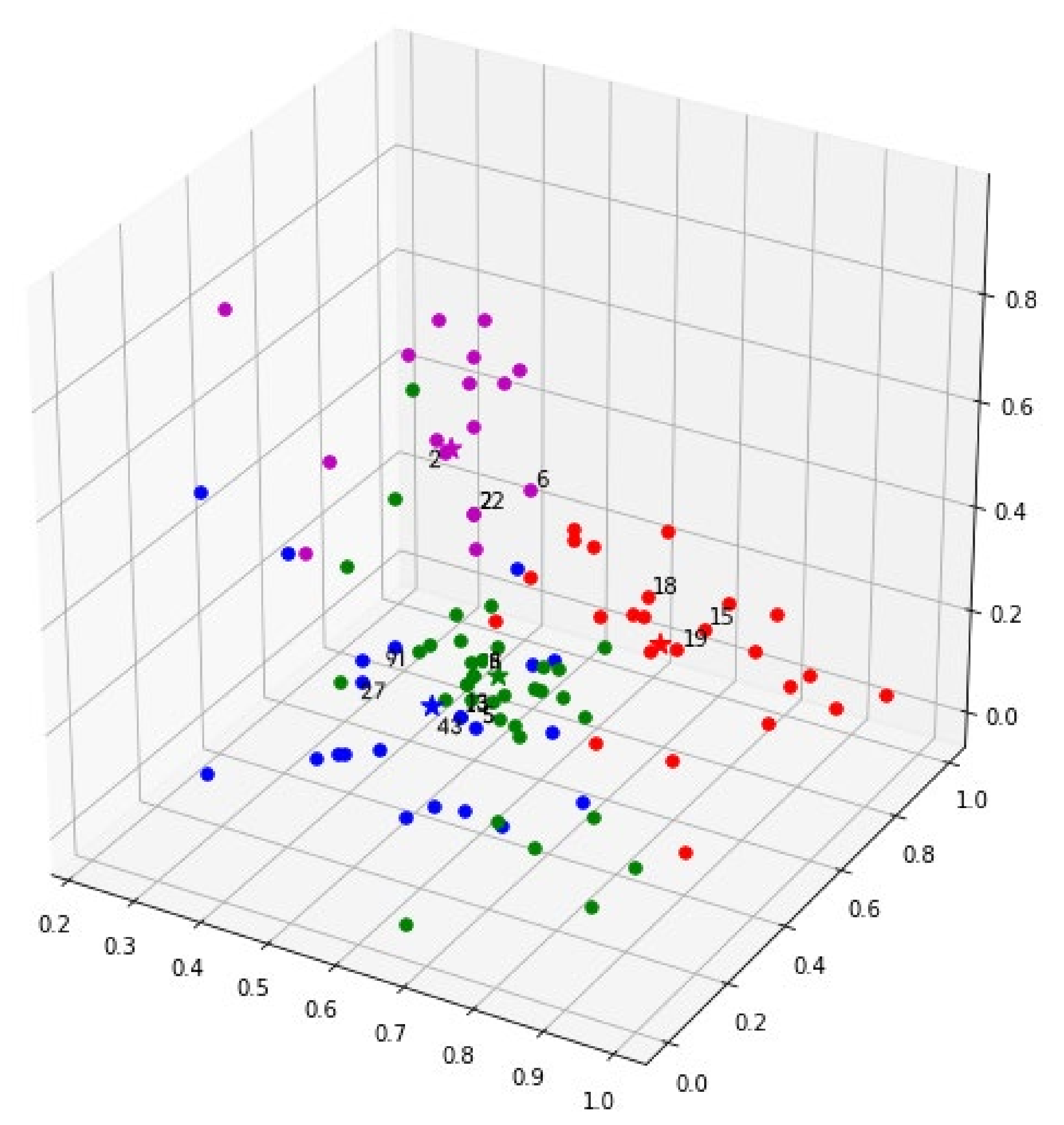

| Number of Items | Sample Size | |
|---|---|---|
| 40 | 63 | 0.963 |
| Number | Name | Image | Feature | Material |
|---|---|---|---|---|
| 1 | Bubble Mart Blind Box | 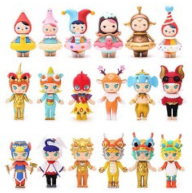 | It has a variety of anthropomorphic shapes with different themes, cute shapes, and gorgeous colors. They can be displayed at home for admiration or you can play with them. | resins and plastics |
| 2 | Spinning Wooden Lollipops | 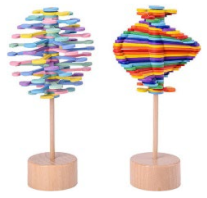 | Its shape could be changed from a lollipop to a sphere. The colors are gorgeous and presented in a layered manner. Users could control the change of the lollipop shape by rubbing the wooden stick with their hands and it will make a crisp sound. | wood |
| ⋮ | ⋮ | ⋮ | ⋮ | ⋮ |
| 100 | Big mouth dragon aromatherapy stove |  | The shape is cute and the color is natural and plain. Incense can be burned inside the big mouth and smoke can come out of the nose. | wood |
| Five Senses | Essential Characteristics |
|---|---|
| Sight | How healing is the color matching? |
| How healing is the shape? | |
| Hearing | How healing is the sound made? |
| Touch | How healing is the texture of the material? |
| How healing is the way of interaction? | |
| Smell (metaphorical) | How healing is the scent conveyed? |
| Taste (metaphorical) | How healing is the flavor conveyed? |
| Cluster | Number and Name | Image | Feature | Material |
|---|---|---|---|---|
| Cluster_0 | P19: Stream Drum |  | It is made of bamboo and wood and has many seeds of plants inside. Its shape is a cylinder and its color is natural and plain. Users could make a sound similar to running water by shaking it. | wood and bamboo |
| P15: Finger Piano |  | Its shape is small and delicate and the color matching is simple. Users could use the finger piano with one hand and make different tones of sound by dialing the metal bars of different lengths. | metal and acrylic | |
| P18: Handmade Temple Block |  | Its raw materials are taken from the fruit of plants, so the shape and color are natural and plain. Users could make it sound by shaking it. | rattan and plant fruit | |
| Cluster_1 | P43: Vent Tomatoes | 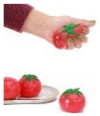 | It mimics the shape and color of tomatoes. It has a soft texture and good elasticity. Users could squeeze it with confidence. | elastoplastic and water |
| P27: Squeeze Eyes Toy |  | They generally have one or two eyes and have bionic shapes and rich colors. Users could make their eyes stick out by squeezing. | rubber and plastic | |
| P91: Pinchable Fruit | 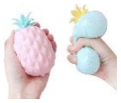 | They imitate the shapes of various fruits, with soft textures and simple color matchings. Users could squeeze them at will with their hands. | rubber and pearl blister | |
| Cluster_2 | P13: Peace Buddha Aromatherapy |  | It has a variety of anthropomorphic shapes, such as sitting and lying positions. The shape is round and cute and the color is mainly pure white. Users insert the lit incense into the hand of the character, which can create a Zen atmosphere. The smoke spirals upward to create a sense of order. | ceramics |
| P8: Hexahedron Maze |  | It is a regular hexahedron with a small ball inside it. The six faces are an independent maze and are connected. Users need to mobilize their spatial thinking ability and sense of balance to move the ball out of the maze. | plastic and acrylic | |
| P5: Oscillating Perpetual Motion |  | It consists of a base, bracket, metal ball, and connecting wire. Shape and color tend towards industrial style. Users could realize the cyclic swing of the metal balls on both sides by moving the metal balls on either side. | metal, nylon, and acrylic | |
| Cluster_3 | P2: Spinning wooden lollipops | 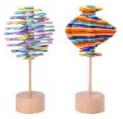 | Its shape could be changed from a lollipop to a sphere. The colors are gorgeous and presented in a layered manner. Users could control the change of the lollipop shape by rubbing the wooden stick with their hands and it will make a crisp sound. | wood |
| P6: Colorful Tangram |  | Before splitting, it is a square, and after splitting, it includes multiple triangles, squares, and parallelograms. It consists of multiple colors. By careful observation, users need to put the disassembled blocks of various shapes into the square box. | wood | |
| P22: Magnetic Plasticine |  | It is a combination of plasticine and magnetic powder. Its shape is changeable and its color is single. Users could move the magnetic plasticine through an iron block. | magnetic powder and plasticine |
| M1 | M2 | M3 | M4 | M5 | M6 | M7 | M8 | M9 | M0 | M1 | Geometric Mean | Weight | |
|---|---|---|---|---|---|---|---|---|---|---|---|---|---|
| M1 | 1.00 | 5.67 | 2.78 | 4.33 | 2.78 | 3.67 | 4.11 | 0.86 | 3.67 | 3.67 | 5.00 | 2.980 | 0.217 |
| M2 | 0.18 | 1.00 | 0.24 | 1.16 | 2.51 | 2.11 | 1.18 | 0.86 | 1.22 | 2.11 | 3.67 | 1.088 | 0.079 |
| M3 | 0.36 | 4.17 | 1.00 | 4.11 | 3.44 | 5.67 | 4.78 | 5.67 | 2.33 | 5.00 | 8.33 | 3.162 | 0.231 |
| M4 | 0.23 | 0.86 | 0.24 | 1.00 | 1.18 | 2.11 | 1.18 | 0.36 | 1.78 | 0.48 | 2.78 | 0.825 | 0.060 |
| M5 | 0.36 | 0.40 | 0.29 | 0.85 | 1.00 | 0.29 | 4.33 | 0.82 | 2.11 | 3.67 | 3.67 | 1.002 | 0.073 |
| M6 | 0.27 | 0.47 | 0.18 | 0.47 | 3.44 | 1.00 | 1.89 | 0.47 | 0.56 | 2.78 | 2.07 | 0.814 | 0.059 |
| M7 | 0.24 | 0.85 | 0.21 | 0.85 | 0.23 | 0.53 | 1.00 | 0.86 | 1.22 | 2.11 | 2.70 | 0.719 | 0.052 |
| M8 | 1.16 | 1.16 | 0.18 | 2.78 | 1.22 | 2.11 | 1.16 | 1.00 | 1.18 | 3.44 | 4.33 | 1.382 | 0.101 |
| M9 | 0.27 | 0.82 | 0.43 | 0.56 | 0.47 | 1.79 | 0.82 | 0.85 | 1.00 | 3.00 | 4.33 | 0.921 | 0.067 |
| M0 | 0.27 | 0.47 | 0.20 | 2.07 | 0.27 | 0.36 | 0.47 | 0.29 | 0.33 | 1.00 | 3.00 | 0.518 | 0.038 |
| M11 | 0.20 | 0.27 | 0.12 | 0.36 | 0.27 | 0.48 | 0.37 | 0.23 | 0.23 | 0.33 | 1.00 | 0.303 | 0.022 |
| AEI | OEI | CEI | Category Score | Coefficient of Determination |
|---|---|---|---|---|
| U1 | M1 | L1 | 0.888 | R2 = 0.794 |
| L2 | 0.699 | |||
| M4 | L8 | 0.718 | ||
| U2 | M3 | L10 | 0.527 | R2 = 0.803 |
| M4 | L9 | 0.922 | ||
| U3 | M3 | L3 | 0.389 | R2 = 0.616 |
| M5 | L12 | 0.793 | ||
| L14 | 0.310 | |||
| U4 | M6 | L16 | 0.860 | R2 = 0.714 |
| M8 | L21 | 0.711 | ||
| U5 | M2 | L15 | 0.500 | R2 = 0.55 |
| M6 | L13 | 0.434 | ||
| M7 | L18 | 0.381 | ||
| U6 | M4 | L7 | 0.275 | R2 = 0.723 |
| M9 | L3 | 0.407 | ||
| M11 | L30 | 0.242 | ||
| U7 | M10 | L28 | 0.592 | R2 = 0.55 |
| M6 | L6 | 0.579 | ||
| U8 | M11 | L31 | 0.527 | R2 = 0.62 |
| Name | Image | Feature | Material | Design Guidelines |
|---|---|---|---|---|
| A1: Landscape wind chimes |  | Its shape incorporates Zen elements such as mountains, water, and the sun. Its color is natural and plain, using the inherent color of the material. There are dozens of metal rods of various lengths. Users could make a pleasing sound by blowing or pulling it. | wood and metal | L1, L2, L3, L7, L8, L9, L10, L12, L13, L14, L21, L28 (the amount of 12) |
| A2: Mood shredder | 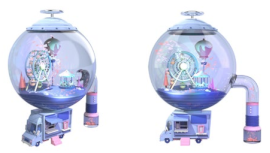 | Its shape consists of two parts: the bottom is similar to a vending car and the top is a sphere with a miniature playground inside. Its color is dominated by less saturated purple, supplemented by pink. When users put a piece of paper into the vending cart, it would rustle. Then, the shredded paper is blown into the sphere, creating a scene of snow falling. | plastic, metal, and rubber | L1, L2, L3, L7, L9, L10, L12, L13, L21 (the amount of nine) |
| A3: Clown’s nose | 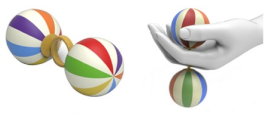 | Its shape consists of two spheres and a ring. The two spheres are colorful and resemble a clown’s nose. Both spheres are made of soft material and users can pinch them. | rubber and plastic | L1, L2, L6, L13, L18, L21 (the amount of six) |
| A4: Interactive squeeze ball |  | Its shape is similar to an ancient seismograph or incense burner and consists of a tray, a base, a track, a top, and two balls. Its colors are classic. Users could make the other ball rotate on the track by squeezing one ball. The greater the frequency and force of the squeezing the faster the ball spins on the track. Additionally, there is a spinning top at the top of the product. | rubber and plastic | L1, L2, L6, L8, L9, L13, L28 (the amount of seven) |
| Evaluation Criteria | P0 | A1 | A2 | A3 | A4 | P19 | P43 | P13 | P2 |
|---|---|---|---|---|---|---|---|---|---|
| M1 | 9.13 | 8.25 | 7.88 | 8.75 | 6.50 | 9.13 | 8.00 | 8.00 | 9.13 |
| M2 | 9.38 | 9.00 | 9.38 | 6.75 | 8.63 | 6.38 | 7.00 | 5.88 | 4.13 |
| M3 | 9.13 | 9.13 | 7.38 | 0.63 | 3.63 | 8.88 | 6.75 | 0.50 | 1.13 |
| M4 | 7.50 | 7.50 | 4.63 | 3.00 | 6.63 | 6.88 | 7.38 | 3.75 | 0.88 |
| M5 | 7.88 | 7.50 | 2.75 | 1.50 | 4.50 | 7.88 | 6.25 | 6.63 | 2.50 |
| M6 | 9.38 | 0.88 | 0.88 | 8.38 | 4.25 | 0.88 | 0.75 | 1.50 | 9.38 |
| M7 | 8.38 | 6.13 | 6.00 | 7.00 | 6.13 | 7.63 | 7.50 | 7.88 | 8.38 |
| M8 | 9.63 | 7.00 | 9.63 | 6.50 | 4.50 | 6.38 | 8.75 | 7.13 | 5.75 |
| M9 | 9.25 | 8.50 | 9.25 | 4.38 | 6.75 | 8.00 | 5.25 | 8.88 | 3.50 |
| M10 | 9.00 | 5.75 | 9.00 | 7.50 | 4.88 | 5.75 | 6.50 | 8.38 | 7.50 |
| M11 | 8.75 | 0.00 | 0.00 | 0.00 | 0.00 | 0.25 | 0.00 | 8.75 | 3.38 |
| Evaluation Criteria | P0 | A1 | A2 | A3 | A4 | P19 | P43 | P13 | P2 |
|---|---|---|---|---|---|---|---|---|---|
| M1 | 1.98 | 1.79 | 1.71 | 1.90 | 1.41 | 1.98 | 1.74 | 1.74 | 1.98 |
| M2 | 0.74 | 0.71 | 0.74 | 0.53 | 0.68 | 0.50 | 0.55 | 0.46 | 0.33 |
| M3 | 2.11 | 2.11 | 1.70 | 0.14 | 0.84 | 2.05 | 1.56 | 0.12 | 0.26 |
| M4 | 0.45 | 0.45 | 0.28 | 0.18 | 0.40 | 0.41 | 0.44 | 0.23 | 0.05 |
| M5 | 0.57 | 0.55 | 0.20 | 0.11 | 0.33 | 0.57 | 0.46 | 0.48 | 0.18 |
| M6 | 0.55 | 0.05 | 0.05 | 0.49 | 0.25 | 0.05 | 0.04 | 0.09 | 0.55 |
| M7 | 0.44 | 0.32 | 0.31 | 0.36 | 0.32 | 0.40 | 0.39 | 0.41 | 0.44 |
| M8 | 0.97 | 0.71 | 0.97 | 0.66 | 0.45 | 0.64 | 0.88 | 0.72 | 0.58 |
| M9 | 0.62 | 0.57 | 0.62 | 0.29 | 0.45 | 0.54 | 0.35 | 0.59 | 0.23 |
| M10 | 0.34 | 0.22 | 0.34 | 0.29 | 0.19 | 0.22 | 0.25 | 0.32 | 0.29 |
| M11 | 0.19 | 0.00 | 0.00 | 0.00 | 0.00 | 0.01 | 0.00 | 0.19 | 0.07 |
| Grey relation () | 0.896 | 0.869 | 0.808 | 0.860 | 0.886 | 0.889 | 0.855 | 0.796 | |
| Ranking | 1 | 4 | 7 | 5 | 3 | 2 | 6 | 8 |
| A1 | A2 | A3 | A4 | P19 | P43 | P13 | P2 | |
|---|---|---|---|---|---|---|---|---|
| Total score | 86 | 77 | 72 | 73 | 75 | 83 | 80 | 69 |
| Ranking | 1 | 4 | 7 | 6 | 5 | 2 | 3 | 8 |
Publisher’s Note: MDPI stays neutral with regard to jurisdictional claims in published maps and institutional affiliations. |
© 2022 by the authors. Licensee MDPI, Basel, Switzerland. This article is an open access article distributed under the terms and conditions of the Creative Commons Attribution (CC BY) license (https://creativecommons.org/licenses/by/4.0/).
Share and Cite
Wu, F.; Lin, Y.-C.; Lu, P. Research on the Design Strategy of Healing Products for Anxious Users during COVID-19. Int. J. Environ. Res. Public Health 2022, 19, 6046. https://doi.org/10.3390/ijerph19106046
Wu F, Lin Y-C, Lu P. Research on the Design Strategy of Healing Products for Anxious Users during COVID-19. International Journal of Environmental Research and Public Health. 2022; 19(10):6046. https://doi.org/10.3390/ijerph19106046
Chicago/Turabian StyleWu, Fan, Yang-Cheng Lin, and Peng Lu. 2022. "Research on the Design Strategy of Healing Products for Anxious Users during COVID-19" International Journal of Environmental Research and Public Health 19, no. 10: 6046. https://doi.org/10.3390/ijerph19106046
APA StyleWu, F., Lin, Y.-C., & Lu, P. (2022). Research on the Design Strategy of Healing Products for Anxious Users during COVID-19. International Journal of Environmental Research and Public Health, 19(10), 6046. https://doi.org/10.3390/ijerph19106046







